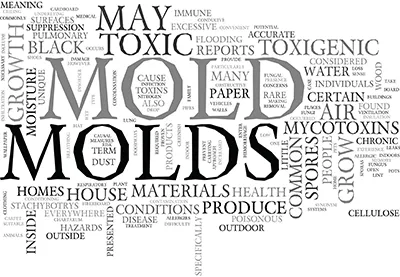Call Us: (754) 247-0122
Mycotoxins & Mold Exposure: Insights from a Top Mold Doctor in Boca Raton

Mold toxicity is often mistaken for other diseases. Have you been having sinus issues, muscle aches and extreme fatigue, but can’t understand why? Mold exposure may be the culprit.
Florida ranks second in the top states for mold risk, so it stands to reason that Floridians should know a great deal about mold. But surprisingly, that’s not the case. Maybe that’s in part because so many Floridians today are not from Florida but have moved or retired here from other states where mold is not as common a problem.
Why is it important to understand mold? First of all, exposure to mold – especially certain kinds of mold, like black mold – can have catastrophic health consequences.
Second, you have to know how to address mold you are being exposed to in order to halt the exposure. Whether it’s your home, office or other work site, or any location where you spend a lot of recreational time - like a dance or art studio, boxing or basketball gym - you need to understand what your options are.
Third, and perhaps most importantly, you have to understand how important it is to treat any illness you may have developed from mold exposure. It doesn’t get better by itself just because you get rid of the mold or stop exposing yourself to the location where the mold is ultimately found.
Let’s start from the beginning with a simple question: what is mold anyway?
What is mold?
Mold is a common fungus. Mycotoxins are the toxic byproducts of invasive mold colonies, and these toxins are the primary cause of mold-related illness. Mold spores, whether toxic or non-toxic, can irritate eyes, sinuses, and worsen asthma for many people. Translate that to mean: all mold is toxic.
Speaking of toxins, we would be remiss in not mentioning the infamous black mold: Stachybotrys chartarum. While not all black-colored molds are as toxic as that particular one, it has certainly focused public attention on its potential to cause severe health issues.
We should also point out that dangerous mold is not always black. The most dangerous of the mold toxins—which include Alternaria, Penicillium, and Fusarium—can impair your health in numerous ways, like hindering your defense against infections or causing liver damage.
Alternaria is a velvety dark brown butit can also range from black to grey. Penicillium is blue green to blue grey, often called blue mold. Fusarium can be pink, red, purple, white, tan, salmon, cinnamon, yellow, or even a combination of these.
Mold in your environment: Where is mold found?
Mold is found both outdoors and indoors. It thrives in warm, humid conditions with low light exposure. Indoors, it develops in areas with moisture, such as in bathrooms, basements or where water leaks have occurred.
Methods to test for the presence of mold in your environment include:
- moisture testing because mold grows in moisture-rich environments
- thermo imaging which allows you to see inside your walls
- mold tests to identify the mold type and include the ERMI (environmental relative moldiness index) test
Once you’ve identified the presence of mold in your environment, getting rid of it may reduce your symptoms and prevent future episodes. Many household cleaners can remove mold, and it is recommended that you wear protective clothing, eyewear, and masks while using them.
Some ways to prevent mold from growing in your home include investing in air purification products, specialized vacuums, water leak detectors, and moisture/water absorbing products.
With serious cases of mold infestation, mold remediation by a professional may be necessary. If you cannot get rid of the mold, moving into a new home or work environment may be necessary.
What happens if you stay in a house with, say, black mold? Keep reading about the effects of long-term mold exposure to find out.
What are the dangers of mold exposure?
The number one danger is that you can develop mold toxicity, also known as mold illness or mold sickness. Biotoxin Illness (Chronic Inflammatory Response Syndrome or CIRS) is caused by exposure to fungi and their spores. Mold illness is a subcategory of Biotoxin Illness.
You may become ill if the mold is toxigenic and causes mycotoxins to spread via its spores. Also, if there are high concentrations of mold in your environment (home, office, etc.) or even your food, you can develop mold toxicity. So, for example, if your food is prepared in an environment that has mold, your food may have enough mold in it to make you sick.
You are more likely to become ill if you’re genetically predisposed to have severe reactions to mold – so mold at levels that don’t make other people sick might still make you ill. Elderly individuals or people with compromised immune systems are also at greater risk of illness from mold exposure, as are children.
What are the signs of mold sickness?
When mycotoxins invade and remain in the body of any otherwise healthy individual, that person’s immune system goes and stays on high alert, mobilizing its resources, constantly fighting back. This level of stress on the immune system can cause inflammation, illness, allergies, and countless related symptoms. Some of the most common signs and symptoms of mold toxicity include:
- red or watery eyes
- runny nose
- rash
- wheezing
- sinus inflammation
- persistent cough
- headaches
- fatigue
Long-term exposure to mold can cause even more serious illnesses. It can trigger your immune system to overreact, which can impair your health in numerous ways, like hindering your defense against infections. Long-term mold exposure can also lead to:
- anxiety
- hair loss
- muscle aches
- abdominal pain
- diarrhea
- weight gain
- insomnia
- impaired memory
In more serious cases, mold toxicity has been linked to everything from recurrent bronchitis and other serious respiratory issues to neurological problems, liver damage and even hepatocellular carcinoma.
How is mold toxicity diagnosed and treated?
The first step is to identify if mold is present in your body, then find where mold is present in your environment that is causing mold sickness.
Mold toxicity can be diagnosed with a series of blood tests, such as a test that detects low vasoactive intestinal polypeptide, whose creation by the hypothalamus is impaired by mold. The type of mycotoxin can be determined with the use of a urine mycotoxin panel. Testing is done using the most up-to-date scientific methods to assure patients receive clear and comprehensive results.
If the tests show mold sickness, or If you have symptoms but do not detect any mold in your environment, it’s possible that you contracted the mold from environments where you work or play. It could be your favorite restaurant where you eat regularly that has a secret mold problem. Or perhaps you’ve recently changed homes, and it was your previous house or apartment building that had mold.
Mold treatment involves a one-two punch: the combination of removing the source of mold and removing mold from your body.
When it comes to finding the right treatment, Dr. Borenstein will work with you to determine which protocol or protocol combination is right for you, as well as the dosage and duration needed. Medications that are often used to help destroy the mold in your body include:
- Itraconazole
- Fluconazole
- Nose sprays like the colloidal silver nose spray Argentyn 23
Consuming a binder is also an option. These substances latch onto mold toxins in your intestines, removing them through excretion and urination. Different types of binders come in liquid or capsule form. You can take binders 30 minutes before you eat. Full results may be seen between six months and two years, with urine testing to monitor your progress.
What kind of doctor should I see for mold exposure?
Oftentimes, physicians provide one mistaken diagnosis after another simply because they do not know how to recognize, test and diagnose for mold-related illnesses. That’s why it’s important to find a doctor who is:
- Experienced in dealing with mold exposure cases
- Knowledgeable about environmental illnesses, in general
- An established functional and integrative medicine specialist, since both medical approaches are uniquely helpful in addressing mold sickness
The technology that detects mycotoxins in the human body has only recently been developed, and there are only a small number of labs that do mycotoxin testing. This is a very specialized area of expertise.
Can you ever get rid of mycotoxins?
In your environment?
Yes, you can get rid of mycotoxins, but it is a massive undertaking. Some people simply choose to move. It’s probably a good idea to hire mold remediation experts, but if you’re doing the mold remediation yourself, know that it requires a comprehensive effort that is focused on removing mold and addressing all your underlying moisture issues that allow mold to thrive, rather than trying to simply chemically destroy the mycotoxins.
In your body?
Again, yes, you can get rid of mycotoxins, but it takes knowledgeable, expert assistance from a physician familiar with the issues surrounding mold and mold exposure, who is also current in the latest technology.
To learn more about mold exposure and its effects on your physical and mental health - or any of the latest treatment options we offer at Manhattan Integrative Medicine of South Florida - contact us online or call to schedule your consultation with Florida’s top functional medicine physician and mold specialist. Complete the form below or call us at (754) 247-0122 today!
Request your consultation today!
Dr. David Borenstein is a top functional medicine practitioner in Florida who recognizes that each patient requires a treatment regimen tailored to his or her individual health profile and specific symptoms. For over 20 years, Dr. Borenstein has been helping patients with the problems of mold exposure and mold sickness.
At Manhattan Integrative Medicine of South Florida, located in Boca Raton, FL, we offer the most up-to-date testing and treatment options. Compile your symptoms checklist and call Manhattan Integrative Medicine of South Florida in Boca Raton, FL at (754) 247-0122 or contact us online.
Serving patients in Boca Raton, West Palm Beach, Jupiter, Boynton Beach, Delray Beach, Parkland, Deerfield Beach, Pompano Beach, Coconut Creek, Coral Springs, Fort Lauderdale, Weston, Hollywood, Pembroke Pines, Aventura, Miami and the surrounding Palm Beach, Broward and Dade County, Florida communities.
Contact Us







